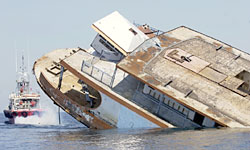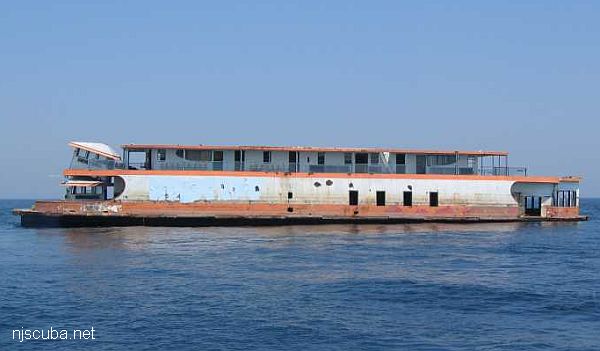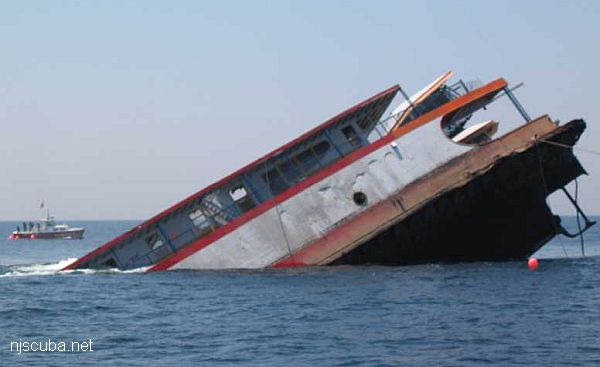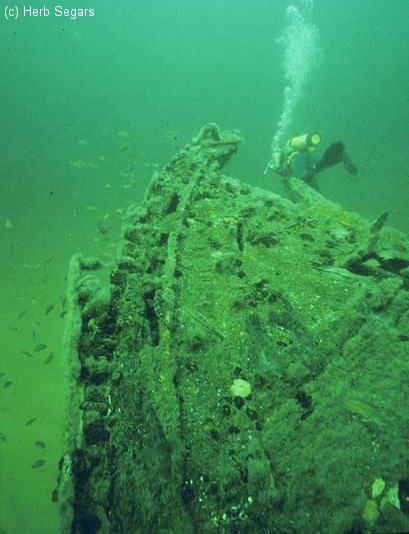Elizabeth "Hooters" (2/2)
FOR IMMEDIATE RELEASE
August 3, 2005
Contact: Peter Boger or Katie Smith
(609) 984-1795
DEP DEPLOYS FERRYBOAT ON ARTIFICIAL REEF SITE
New Program Provides Reef Materials as Part of Governor's "Coast 2005" Initiative
(05/106) CAPE MAY --the New Jersey Department of Environmental Protection (DEP) today deployed a decommissioned ferryboat on the state's Cape May artificial reef site. The deployment will help to improve New Jersey's artificial reefs and is part of the commitment made by Acting Governor Richard J. Codey's "Coast 2005" initiative.
"The Jersey Shore is one of our greatest natural resources and most important economic engines, " Governor Codey said. "Today's artificial reef deployment improves coastal resources while keeping the shore a quality part of the Jersey experience for future generations."
"Our artificial reef program provides tremendous benefits to fishermen, divers, and our shore economy, while also providing new marine habitat," said DEP Commissioner Bradley M. Campbell. "New Jersey is a national leader in artificial reef management and we remain committed to enhancing these reef sites for the dual benefit of our environment and economy."
The ferryboat, known as the "Elizabeth, " was located in the Philadelphia harbor prior to its deployment and has been decommissioned for some time, previously having been used as a restaurant. The vessel will be 36 feet tall underwater, as DEP's preparations included the removal of its pilothouses, 60 feet wide and 220 feet long. It will provide two long, open corridors that should attract both fish and divers.
DEP acquired the ferryboat through a $100,000 appropriation for the deployment of three vessels on artificial reef sites. Earlier this year, the state sank a decommissioned navy tanker, dubbed the "Helis" after the beluga whale that had recently been spotted in the Delaware River, on the Garden State North artificial reef site. The state will deploy the remaining vessel later this year. DEP is placing the three ships at reefs along the entire Jersey coast so that as many residents as possible can enjoy the benefits of these new acquisitions.
Artificial reefs play an important role in supporting New Jersey's marine fishing and diving industries, whose activities on the reefs alone generate more than $50 million and overall provide more than $850 million to New Jersey's economy. In one study, DEP determined that one out of every five fish caught by recreational anglers in New Jersey's marine waters during 2000 was caught on a reef site.
Earlier this year, Governor Codey announced his "Coast 2005" initiative, which includes a variety of programs designed to enhance coastal water quality and improve coastal ecosystems. Aside from the reef-building program, the initiative includes new standards for maintenance and inspection of sewer systems to help prevent spills from polluting New Jersey's waters; $30 million in grant funding to assist municipalities in developing stormwater management plans; and strengthening coastal zone restrictions for offshore oil and gas development.
The DEP initiated its ocean reef-building program in 1984, establishing over time a network of 14 reef sites from Sandy Hook to Cape May that encompass a total of 25 square miles of seafloor. The state has made more than 3,500 deployments of various reef materials - more than any other state in the country - including ships and barges, massive undersea ridges from six million tons of rock, and thousands of fabricated concrete reef units.
Artificial reefs can provide important habitat for many of New Jersey's marine species, with up to 200 species of fish and invertebrates known to colonize our reefs. Reefs also have 800 to 1,000 times more biomass than open ocean and can form important nurseries for juvenile fish.
In October 2004, DEP issued for public comment the most recent draft of its Artificial Reef Management Plan that covers all aspects of the multi-faceted program, including its objectives, history, benefits, site selection and other considerations. The new plan also establishes a protective standard for the stability, durability, and effectiveness of various materials used in reef construction. Currently, there is no uniform national standard for the durability of reef materials.
The 4.5-square mile Cape May Reef Site where today's deployment occurred is approximately 8.5 miles offshore from Cape May and is comprised of more than 75,000 cubic yards of vessels, tanks, tire units, specially-designed "reef balls" and other materials. In 2003, it was one of five artificial reefs where New Jersey deployed 250 decommissioned New York City subway cars.

Sinking of the vessel consisted of cutting a single hole in the ferry's one watertight compartment. Prior to deploying the ferryboat at the reef site, DEP supervised cleaning of the tanker to remove all greases, floatables and other materials that might be harmful to the marine environment. The U.S. Coast Guard inspected the cleanup of the ship prior to allowing DEP to transport it to the reef site.
This vessel is the 135th ship to be sunk on New Jersey's artificial reef sites.




Questions or Inquiries?
Just want to say Hello? Sign the .